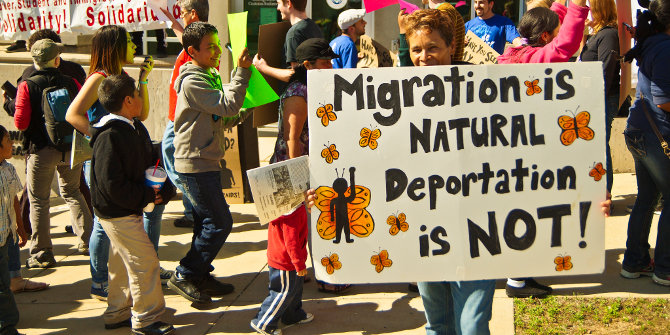
 For the unhoused, having a criminal record makes it even more difficult to gain employment, education, and housing. R. Neil Greene and Noah Painter Davis look at the role of diversion practices which minimize contact with and the consequences of the criminal-legal system. Building on their work on youth and young adult diversion with New Mexico judicial officials and The New Mexico Sentencing Commission, they write that systems which link diversion with healthcare and educational assessments and assistance can help reduce both contact with the criminal-legal system and homelessness.
For the unhoused, having a criminal record makes it even more difficult to gain employment, education, and housing. R. Neil Greene and Noah Painter Davis look at the role of diversion practices which minimize contact with and the consequences of the criminal-legal system. Building on their work on youth and young adult diversion with New Mexico judicial officials and The New Mexico Sentencing Commission, they write that systems which link diversion with healthcare and educational assessments and assistance can help reduce both contact with the criminal-legal system and homelessness.
There are troubling relationships between being unhoused and having contact with the criminal-legal system (CLS). Many who experience housing instability have previous convictions for minor criminal offenses and many of those incarcerated in jails and prisons have a history of homelessness. Inadequate affordable housing has the greatest influence on homelessness. However, substance use, and mental health disorders are also frequently implicated—and are factors that increase contact with the criminal-legal system.
Diversion and homelessness
Having a criminal record is a roadblock to exiting homelessness—it restricts options for education, employment, and housing, all factors that are important for reducing crime and CLS contact. As such, we advocate for practices that minimize contact with and consequences of the CLS. These practices are referred to as diversion. Diversion can happen at different points in the CLS process, including at the front end of the system, such as before arrest (often called deflection) or prior to a charge being filed, or at the back end of the system, such as when those convicted of a crime are diverted from incarceration. Some diversionary practices only involve a warning while others link clients to support systems and treatment services. Diversion is cost effective and can reduce future criminal legal system contact. Diversion practices tend to be more effective if they avoid giving a client a criminal record, and the accompanying stigma it carries. Removing the barrier of a criminal record may be particularly important for those who are unhoused. Diversion practices may be more effective when they involve collaborations across sectors, e.g., such as public health and the CLS. These collaboratives can draw on a broader range of resources and a greater array of solutions to address community concerns and public safety issues.

Photo by Tim Mossholder on Unsplash
Although such programs are promising, there are distinct challenges to scaling out effective diversion practices, including insufficient data systems, resistance to harm reduction practices, and structural barriers to education and employment. These barriers are particularly relevant for the unhoused who face additional disadvantages—including the stigma of being unhoused, lack of stable living environments to support recovery, and additional unmet needs. Other challenges to diversion include figuring out the appropriate balance between using coercive tactics to participate and comply with diversion programs, with incentives for participating and more lenient responses to program violations. This, in some cases, may involve moving from strict abstinence-based approaches to those that are more in line with principles of harm reduction. Historically, criminal-legal system (CLS) approaches have over relied on coercion and consequences and have underinvested in incentives and supports.
Improving diversion for youth and young adults in New Mexico
There is an increased interest in the use of diversion practices nationally and in our state of New Mexico. We are working with New Mexico’s First District Attorney’s Office and The New Mexico Sentencing Commission to improve, develop, and evaluate diversion practices for youth (ages 12-17) and young adults (18-25). We are assisting in the development of their information and data system so that we can better identify cases where people are eligible for diversion and evaluate the impact of diversion practices on recidivism, service engagement, and recovery. We want to develop information systems that help ensure diversion is administered in ways that reduce inequities by race, ethnicity, and socioeconomic status and increase the use of practices that are responsive to the specific needs of clients.
We are working to build support systems for those that are diverted and their families. Linkage facilitation is a key example of this. Here, health navigators engage with individuals and their families to address unmet needs and to support connection and engagement with services, education, and employment opportunities.
Cascade of Care and aiding recovery
Linkage facilitation practices help integrate a public health approach to problems formerly dealt with by more punitive measures. Such programs and practices have been promoted by the National Institutes of Health’s’ Justice Community Opioid Innovation Network (JCOIN) which is a consortium of researchers, criminal legal system practitioners, and treatment providers tasked with improving the quality of care for individuals with opioid use disorder (OUD) in justice settings. We are incorporating insights from JCOIN and similar initiatives into our work. These include emphasizing the importance of adhering to the Cascade of Care—an ideal sequence of care in which a problem (e.g., substance use, disease) is identified by an initial screening and the next stages unfold as they are needed and appropriate, including clinical assessment, creation of treatment plan, referral, treatment initiation, engagement, and retention. A growing body of evidence suggests that the Cascade of Care is effective—for example, CLS involved individuals who have a substance use disorder are much less likely to overdose and to offend again if they receive an appropriate Cascade of Care. We are enhancing this work by paying greater attention to different forms of stigma that may impede connections to needed resources and recovery efforts more broadly.
Although it is critical to develop front end diversion practices that intervene as early as possible, it is important that we continue to help those who have experienced prolonged contact with the CLS including those released from prison. These individuals often experience housing instability and have high rates of recidivism. One opportunity to improve the reentry process comes from the expansion of the PELL second chance grant which provides need-based assistance for secondary education. People with criminal records had been ineligible for PELL until its recent expansion. Education opportunities play a vital role for career advancement, housing stability, and lessening legal system involvement. We are currently working to develop a Prison Education Program via Second Chance Pell at the University of New Mexico. The success of the program will hinge in part on addressing barriers to reentry, such as housing instability.
We know that once unhoused an individual is at greater risk for legal system contact. Thus, addressing the need for housing support is key and diversion efforts are essential to this equation. We must also support the decriminalization of behaviors related to housing instability and continue to support expanded education and employment opportunities—with better affordable housing options. All of which can help end homelessness and decrease CLS contact and its consequences.
- Funding note: Our research is funded by several sources. Our primary source of support is a William T. Grant Foundation Reducing Inequality Grant. We have also received in-kind funding from the New Mexico Sentencing Commission and grants from the University of New Mexico’s Center for Regional Studies and the Con Alma Foundation to support community engagement. R. Neil Greene is currently funded through an NIAAA Institutional Research Training Grant, 5T32 AA018108.
- This article is based on the chapter ‘Housing instability and the criminal legal system’, in the new book, Beyond Bars: A Path Forward from 50 Years of Mass Incarceration in the United States.
- Please read our comments policy before commenting.
- Note: This article gives the views of the author, and not the position of USAPP – American Politics and Policy, nor the London School of Economics.
- Shortened URL for this post: https://bit.ly/45RHG1V






